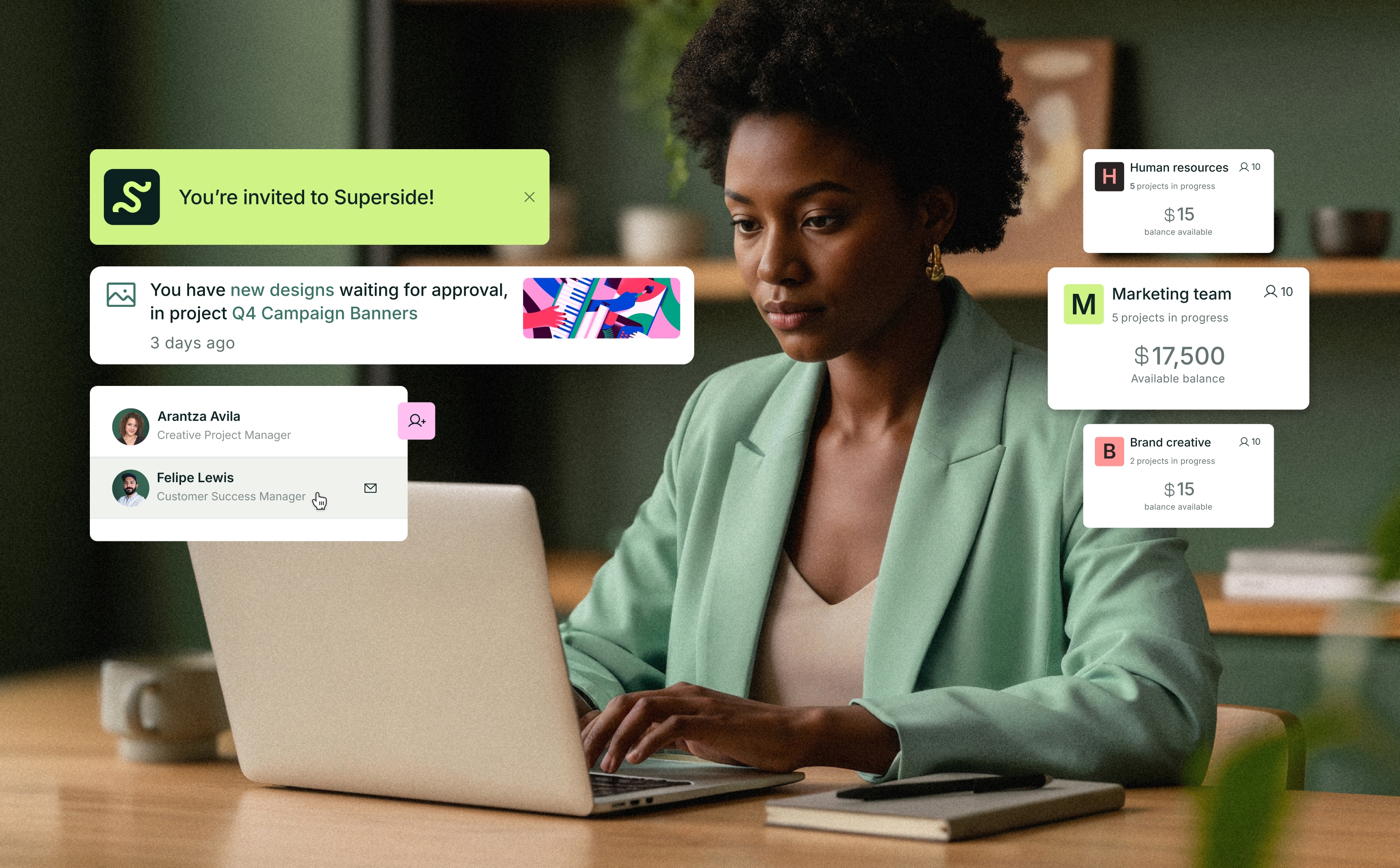
TLDR: Scaling video marketing means moving at lightning speed. It calls for being clever with your workflows—templatizing, recycling, appeasing algorithms and recognizing when you need help.
There’s a saying among marketers: “Content is king”. And they’re right. Content is the vehicle for the message, and the message is what people remember.
If content is king, video is the king’s favorite noble. It’s the quickest way to make an emotional connection in saturated mediums, and amplifies your message using everything you’ve got: animation, motion graphics, branding and beyond. When the king wants to send a message, Lord Video is the name called.
Despite this, creative marketers have been suspiciously slow to rise on video. Sure, they’ve got one or two people with decent cameras and Premiere Pro… but it’s not enough to make a dent in the market.
Here, creative marketers, is how you can hack your video marketing engine for scale.
Why Scale Video Marketing?
Plenty of readers have a “nope” cued up at this point. Giving video the time it deserves seems expensive, technically difficult, unapproachable, and hard to pin a dollar value to.
So… what makes going big on video marketing worth your time? Well, here are some figures from our own balance sheet. Since we started pumping gas into video, we’ve seen:
- An 87% increase in video views from Google SERPs.
- A 300% increase in clicks on content with video.
- 63% of our 2022 videos appearing on the first page of Google search results for their specified terms.
- Over 31k organic video views on YouTube last year alone (for a channel used only sparingly in years prior).
- 48% improvement in a key campaign’s click-through rate, and a 62% drop in cost per lead. Just by adding a human face and narration to an ad for an eBook.
- Ads with video that convert at a 30% higher rate to demo requests when compared to animation-only ads or static ads.
We’ve generated nearly 3,000 demo requests with video since late 2020, with millions of dollars in our pipeline to show for it. Our ABM team tells us nearly 50% of new opportunities are driven by video marketing. Video is no longer “nice to have”. Unless your business exists outside the internet, scalable video is your best shot at staking your claim now.
How to make it happen on your team.
Every new project seems insurmountable until you start doing it. Many businesses get stuck in the interim, knowing they’d be pulling bigger numbers with video at the helm, but worrying about straying too far from traditional methods with greater perceived ROI.
Below are a few hacks that’ll help you kick the training wheels off your current video marketing program.
1. Templatize, Standardize Everything
Things are scalable when things are easily repeatable. As much as we’d all like to think of every video as its own unique gem, scale comes from finding your format and working within it. Look to your existing video library, and note which ones worked best. Find the commonalities, write them out and build a template around them.
You can get as granular as you like with it. Be as broad as writing out a general story format, or as minute as the shot list. You probably won’t follow the latter to a T every time, but the clearer your guidelines, the faster you can move. If you’ve got multiple styles of video (and for a modern business, you really should), create multiple templates.
Work smart, not hard.
Josh Gonsalves, who helms marketing video production management at Superside, explains how we ramped up video quickly on our own.
“The first thing we did was create a ton of templates to speed up our production,” Gonsalves says. “For ads, we create pre-rendered animated components that we can easily drag and drop into our ads, and rearrange based on what the ad’s focused on.”
He says setting up a few solid templates in your video editor is a fast-tracker. “We also have a bunch of Premiere Pro templates, many of which already include commonly used assets. Everything from animations for our YouTube videos to adjustment layers that automatically color-correct our footage.”
Most project management software is similarly templatized, so Gonsalves suggests creating a template that fits your video production M.O.
“The other thing we’ve done is standardized our video production process in our project management tool, so we’ve scaled our video production without getting overwhelmed with tons of projects.”
2. Strip the Meat from Every Asset, Repurpose It
However big or small your team is, you most likely have some kind of marketing material lying around. Maybe it’s a blog, or a particularly compelling case study, or stray bits of a webinar. Whatever it is, don’t waste that meat.
A blog or case study can be the basis for a video. Hell, the script is basically written for you. The story beats are all there. The webinar where your speaker hit all of your talking points unprompted? Cut it up pretty and ship it off. Cut it with footage from other webinars with other speakers singing your song.
Work smart, not hard.
We do stuff like this all the time, and it’s why those numbers up top look the way they do. All can be made video. All should be made video.
Modern video marketing operates at a vicious pace. If you’re not uploading a YouTube video and IG reel once a week, a TikTok once a day (pending your audience), and frequent Facebook posts for the oldies, you’re not scaling. That’s why we reduce, reuse and recycle wherever possible.
Be shameless in your recycling of old content. After all, it’s a new medium you’re using with a fresh approach. Even if people have seen it before, the new coat of paint extends its novelty and reiterates the message.
3. Evaluate Your Video Marketing Team
Remember that gut feeling from earlier? The one that told you you didn’t have the resources to make video happen? Well, it may be partially correct. If you don’t have a video team brimming with veteran video producers, all of whom have the capacity to produce multiple assets for multiple mediums on a weekly basis, scaling video meaningfully may continue to elude you.
You may be wondering whether or not this high cadence of content is necessary to scale. Yes, yes it is. See, reliability determines your video engine’s success as much as the content therein. The stories of companies who went “viral” are statistically nonexistent compared to the hundreds of thousands trying to go viral every day. Especially in the B2B world, virality is often a slip-up—a joke that the business didn’t know they were making, but the viewers did. B2C brands have an easier time going viral, but successes are still anomalies.
Constant, well-produced video content is what builds brand affinity and extends reach. If your video team can’t make your voice omnipresent in your space, they’ll always be chasing a carrot on a stick.
Work smart, not hard.
Many brands are trying and failing to keep up with the cadence necessary for scale. But like the fledgling YouTuber or TikTok star (bear with me), a commitment to the medium and the right partnership can change everything.
Brands tend to lean on CaaS (creative as a service) for this stuff. Access to a creative team with years of video experience across every imaginable industry allows them to give and take the reins on video as it suits them. Want to set the cadence, send the brand guidelines and take your hands off the wheel? All good. Want to painstakingly storyboard each asset and place it in capable hands? You got it. If you want to truly fast-track video marketing, CaaS is the only route. There’s no substitute for creative support that consistently delivers the goods without adding heads/exploding budgets.
Kyle Weber, senior creative copywriter and friendly face of many a Superside video, suggests segmenting your video efforts with a CaaS partner by top- and bottom-of-funnel assets.
“If you have to focus your efforts somewhere, focus on bottom-of-funnel videos that require the most inside knowledge of your services, tech and so on,” Weber says. “These are the videos that are hardest to outsource. Invest your own time and knowledge into your bottom-of-funnel videos. Trust your partner with the top-of-funnel videos that lean less heavily on information, and more on creativity and engagement.”
4. Have Video for Every Format
Different mediums require different inputs. Your prospects likely frequent more than one watering hole, so every asset should have several counterparts formatted to fit how each platform most favors its content.
This is where many brands get a little lazy—and they pay for it, algorithmically. Many opt to simply slap their YouTube video into an IG story or reel, giving little mind to the complete technical and tonal differences between the platforms. Many algorithms deprioritize content that’s not fit to their (surprisingly restrictive) standards, effectively punishing you for making their platform look bad. Yes, the internet is cruel.
Work smart, not hard.
We cut, paste and repurpose if it’s possible to do so without harm, but often end up creating each platform’s video option from scratch to appease both the viewer and the algorithm. A YouTube video has a completely different vibe from a TikTok with the same message, an IG story or reel is shot for an entirely different frame size, etc.
Unless you’ve got a team of video experts in your back pocket (or secretly are one yourself), it can be hard to quickly create, iterate on and deliver videos that fulfill each platform’s deepest desires. It shouldn’t surprise anyone that ambitious brands often opt for a “set it and forget it” policy in this area, looking to their CaaS partners to amplify the roar of their mighty video engine with platform-specific video content.
5. Leverage UGC Wherever Possible
What user-generated content (UGC) sometimes lacks in professionalism, it makes up for in believability. This is someone openly touting your tenets, peddling your praises—it means more from them than it does from you, even at your best. UGC’s been shown to be 20% more influential towards purchasing decisions, even for B2B brands.
The only problem is that it can be difficult to source. You’ll most often have to pay an influencer for usable UGC, unless you can frequently coax existing customers into sharing their experience with your brand.
Work smart, not hard.
Alternatively, be the sneaky little marketer you know you are. Make it look like UGC, but use your own talent. We found that, to the average onlooker, it’s all the same. Resident video wizard Weber says it’s the one time it’s acceptable to get your lo-fi on.
“Go all in on lo-fi video content that can be produced fast without a truckload of expensive equipment or niche expertise,” he says. “If you take a UGC approach, anyone on your team with a phone and a social account can become a video marketer, editor, actor etc.”
As with all things creative, it’s easier with CaaS. Partners with extensive experience working the UGC angle know the ropes best, and know how to swing them in your favor.
Scaling Video Isn’t Hard, Just Different
Since 2020, Google’s shown video thumbnails in over 25% of search results. That number’s only increasing, and it’s signaling a growing competitive advantage for brands willing to start giving video its due.
If you want a decade’s worth of historical data showing the correlation between scalable video and marketing ROI, you can play the waiting game. But know that while you’re doing that, other creative marketers are assembling the puzzle pieces; actively taking their industry channels by storm by investing in a video engine that produces immediate marketing outcomes.
Waiting is easy, but that doesn’t make scaling video hard. It’s not difficult—it’s just different. It doesn’t take deep technical acumen and a dozen videographers with walls of expensive equipment. It just takes investment.
















